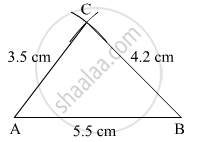Advertisements
Advertisements
प्रश्न
In ΔABC, l(AB) = 5.5 cm, l(BC) = 4.2 cm, l(AC) = 3.5 cm
उत्तर
Steps of construction:
- Draw a line AB = 5.5 cm.
- With A as a centre and 3.5 cm as the radius, draw an arc above the line AB.
- With B as the center and 4.2 cm as the radius, draw an arc cutting the previous drawn arc at point C.
- Join CA and CB.
Δ ABC is thus the required triangle.

संबंधित प्रश्न
In ∆ STU, l(ST) = 7 cm, l(TU) = 4 cm, l(SU) = 5 cm
Draw triangle with the measures given below.
In ∆PRS, l(RS) = 5.5 cm, l(RP) = 4.2 cm, m ∠R = 90°
Construct ∆EFG from the given measures. l(FG) = 5 cm, m∠EFG = 90°, l(EG) = 7 cm.
Construct a triangle using the given data: DE = 5cm, ∠D = 75° and ∠E = 60°
Construct a right-angled triangle in which: Side AB = 4.5 cm and hypotenuse AC = 7 cm
Construct an isosceles triangle in which: PQ = QR, PR = 4.5 cm and ∠R = 60°
Construct an equilateral triangle using the given data: Altitude PM = 3.6 cm
Construct an equilateral triangle using the given data: Altitude OM = 5.8 cm
Construct a triangle using the given data: Perimeter of triangle is 10.6 cm, and the base angles are 60° and 45°
Construct a ΔXYZ with YZ = 7.5 cm, ∠Y = 60° and ∠Z = 45°. Draw the bisectors of ∠Y and ∠Z. If these bisectors meet at O, measure angle YOZ.
